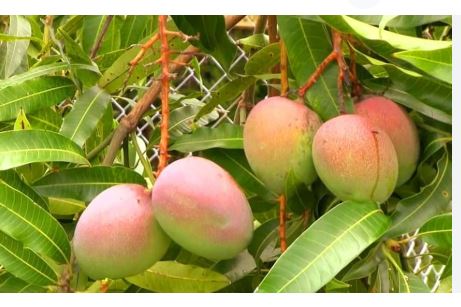
Haden mangoes fall under the species Mangifera indica, a tropical evergreen within the Anacardiaceae family, alongside relatives like cashews and sumac. Originating from South Asia, this species has been bred into countless cultivars, with Haden standing out as a pivotal variety in modern mango cultivation. Its botanical lineage ties it to the broader mango family, known for its juicy, single-seeded drupes.
The Haden mango was born in Florida, USA, in the early 20th century. It traces back to 1910, when Captain John J. Haden, a retired army officer, planted mango seeds from a ‘Mulgoba’ cultivar imported from India on his Coconut Grove property. One seedling bore exceptional fruit, and his wife, Florence, championed its propagation. By the 1920s, nurseryman George Cellon grafted and distributed it, naming it after the Hadens. It became Florida’s leading commercial mango through the mid-20th century, paving the way for varieties like Tommy Atkins (its offspring), though its prominence later waned due to disease susceptibility.
Haden mangoes are medium to large, weighing 16–24 ounces, with a rounded-to-oval shape. Their thick skin ripens from green to a stunning mix of red, yellow, and orange, often with a glossy sheen and faint speckling. The flesh is deep yellow-orange, smooth, and mostly fiber-free, encasing a medium-sized pit. Their taste is a rich, classic mango profile—intensely sweet with a hint of tartness, layered with peach-like and tropical notes. The juicy, aromatic flesh makes them a standout for fresh eating, though they soften quickly once ripe.
Haden mangoes pack a nutritional punch. A cup (about 165 grams) offers around 100 calories, with high vitamin C for immune and skin health, and vitamin A for vision support. They provide 3 grams of fiber for digestion, plus potassium, magnesium, and small doses of B vitamins for energy and heart function. Antioxidants like quercetin and mangiferin may reduce inflammation, while enzymes like amylases aid digestion. Sensitive folks should note the skin’s urushiol content, which can cause mild irritation, a trait shared with poison ivy kin.
Haden mango trees thrive in USDA Hardiness Zones 10–11, needing warm, frost-free climates with temperatures above 40°F (4°C) and ideally 70–95°F (21–35°C). They demand full sun and a tropical setup—dry winters to spark flowering, followed by humid summers for fruit growth. In the U.S., they’re suited to South Florida, parts of California, and Hawaii, though they’re less hardy than some cultivars. Growers outside these zones often use greenhouses, as cold snaps can stunt or kill them.
Culinary Applications of Haden Mango
- Fresh Eating: Sliced or scooped, their rich, fiber-free flesh offers a pure, tropical treat straight from the skin.
- Smoothies: Blended with pineapple or coconut milk, they create a creamy, flavorful base with a vibrant orange hue.
- Salsas: Diced with red onion, cilantro, and a splash of lime, they add a sweet-tart zing to shrimp or pork dishes.
- Desserts: Pureed into sorbets or folded into cheesecakes, their intense sweetness shines without extra sugar.
- Salads: Cubed and mixed with avocado or spinach, they bring a juicy pop to light, summery plates.
- Grilling: Halved and lightly charred, they pair beautifully with grilled chicken or fish, enhancing savory flavors.
- Chutneys: Simmered with ginger and chili, their floral notes make a bold, tangy condiment for curries or cheeses.
- Cocktails: Muddled into margaritas or pureed for bellinis, they infuse drinks with a lush, peachy-mango kick.
Cultivation of Haden Mangoes
- Climate: Gala thrives in temperate climates with cold winters (500-1000 chill hours below 45°F/7°C) and warm summers (70-85°F/21-29°C), balancing dormancy and fruit ripening needs.
- USDA Zones: Best suited to USDA zones 4-9, excelling in 5-8 where winters reach -20°F (-29°C) and summers support flavor development. Zone 4 requires frost protection during early bloom.
- Soil: Requires well-drained, loamy soil with a pH of 6.0-7.0, enriched with organic matter. It tolerates sandy or clay soils if drainage is ensured to prevent root stress.
- Sunlight: Demands full sun (6-8 hours daily) for optimal fruit size, sweetness, and red-orange striping. Partial shade diminishes yield and color intensity.
- Planting: Propagated via grafting onto rootstocks like M9 (dwarf) or MM106 (semi-dwarf) for size control and earlier fruiting (2-4 years). Space trees 10-15 feet apart in rows 15-20 feet apart, planted in late winter or early spring.
- Watering: Needs consistent moisture—1-2 inches weekly—especially during bloom, fruit set, and summer growth (April-August). Drip irrigation prevents wet foliage; mature trees tolerate mild drought with deep watering.
- Support: Young trees require staking for 1-2 years to establish against wind due to shallow roots. Trellising or espalier systems in orchards enhance airflow and sun exposure for better fruit quality.
- Pollination: Early-blooming flowers (April, flower group 2-3) need cross-pollination with varieties like Fuji, Honeycrisp, or Granny Smith blooming concurrently. Bees are essential; place pollinators within 50-100 feet or use hives.
- Pests: Susceptible to codling moths, apple maggots, and aphids. Use pheromone traps, organic sprays (e.g., spinosad), or netting; natural predators like ladybugs help control infestations.
- Diseases: Prone to fire blight, apple scab, and powdery mildew. Prune for ventilation, apply sulfur or copper pre-bloom, and remove infected parts—rootstock choice can improve resistance.
- Harvest: Fruits ripen early to mid-season (August-September), picked when red-orange blush covers 50-90% of yellow base and flesh is firm (15-17 lbs pressure). Harvest in stages; yields 50-150 lbs per mature tree.
- Yield: Begins fruiting 2-4 years after planting, peaking at 5-10 years with 100-200 apples per tree under good care. Thin fruit (1 per cluster, 6-8 inches apart) in June to boost size and prevent biennial bearing; lifespan reaches 30-50 years.